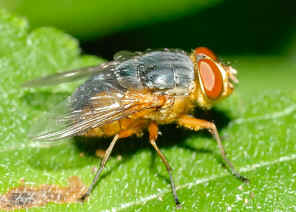Blowfly - Family Calliphoridae
This page contains pictures and information about Blowflies in family Calliphoridae that we found in the Brisbane area, Queensland, Australia.

- The Blowfly family includes the Bluebottles and Green-bottles. Most of the flies in this family are metallic green or blue colour. Others are mixtures of brown and dark grey. They are medium to large in size. There are bristles on the both sides of their thorax and abdomen tip.
- Adult Blowfly feeds on nectar, honey dew and other sweet liquid, or liquid products of organic decomposition. Most Blowflies are active during day time.
- Blowflies can be distinguished by by wing vein M1+2 bent forwards with angle and reaching R4+5. Except those in Rhiniinae, the antennal arista is usually plumose. Usually their face have a strong keel-like carina. The calypters are well developed. They have no striped on thorax and no subscutellum, except for a weak one in Ameniinae.
- Blowfly larvae usually live in carrion or dung, which help for decomposition. Some species live on the animal's body where the larvae attack weakened or broken tissue. Some species are parasitic on earthworms or land snails. Some live in termites or ants nest.
- We found four subfamilies in Brisbane. We found quite a number of them and listed as follows.
 Subfamily Calliphorinae
All blowflies we found in this subfamily are in
Genus Calliphora. They are commonly known as Golden
Blowflies. They have the abdomen in mottled gold colour with greyish-blue
thorax. Their legs are from yellowish-brown to dark brown, but never
black.
Subfamily Calliphorinae
All blowflies we found in this subfamily are in
Genus Calliphora. They are commonly known as Golden
Blowflies. They have the abdomen in mottled gold colour with greyish-blue
thorax. Their legs are from yellowish-brown to dark brown, but never
black. Subfamily Luciliinae
Member in this subfamily are carrion feeders.
They are either metallic green in colours.
Subfamily Luciliinae
Member in this subfamily are carrion feeders.
They are either metallic green in colours. Subfamily Chrysomyinae
Flies in this subfamily are either metallic green or blue in colours. The
antennal arista is strongly plumose. As the subfamily Calliphorinae above,
they are also carrion feeders. There is one genus Chrysomya in
this subfamily.
Subfamily Chrysomyinae
Flies in this subfamily are either metallic green or blue in colours. The
antennal arista is strongly plumose. As the subfamily Calliphorinae above,
they are also carrion feeders. There is one genus Chrysomya in
this subfamily. Subfamily Rhiniinae
Flies in this subfamily Rhiniinae are small to medium in size with narrow
body. The thorax is covered with short setae. Their larvae are associated with
ant or termite nest. Those flies are sometimes found feeding on
flowers. Some reference put this group as family Rhiniidae.
Subfamily Rhiniinae
Flies in this subfamily Rhiniinae are small to medium in size with narrow
body. The thorax is covered with short setae. Their larvae are associated with
ant or termite nest. Those flies are sometimes found feeding on
flowers. Some reference put this group as family Rhiniidae.
 Subfamily Ameniinae
The flies in this subfamily also has the subscutellum which is the characteristic
of Tachinid. This large Blowfly is metallic dark blue-green in colour with the bright
orange-yellow colour face. On the thorax and abdomen there are the shiny white spots
patterns. Different individuals may have slightly different patterns. This fly
is nectar feeder and assist the flower plants for pollination. We have a lot of
pictures and information in this page.
Subfamily Ameniinae
The flies in this subfamily also has the subscutellum which is the characteristic
of Tachinid. This large Blowfly is metallic dark blue-green in colour with the bright
orange-yellow colour face. On the thorax and abdomen there are the shiny white spots
patterns. Different individuals may have slightly different patterns. This fly
is nectar feeder and assist the flower plants for pollination. We have a lot of
pictures and information in this page.
- Reference:
- 1. Insects of Australia, CSIRO, Division of Entomology, Melbourne University Press, 2nd Edition 1991, p781.
- 2. Insects of Australia and New Zealand - R. J. Tillyard, Angus & Robertson, Ltd, Sydney, 1926, p375.
- 3. On the Fly, The Interactive Atlas and Key to Australian Fly Families CD Rom - Hamilton, J. et al. 2006. Brisbane : CBIT & ABRS.
- 4. Northern Territory Insects, A Comprehensive Guide CD - Graham Brown, 2009.
- 5. Family CALLIPHORIDAE - Australian Biological Resources Study, Australian Faunal Directory.
- 6. GENUS CHRYSOMYA IN NEW GUINEA (Diptera : Calliphoridae) - By Maurice T. James, Pacific Insects 13 (2): 361-369, 1971.
- 7. A Revision of Australian Rhiniinae (Diptera : Calliphoridae) - J. P. Dear, Aust. J. Zool., 1977, 25, 779-826.
- 8. Calliphoridae - PaDIL.
